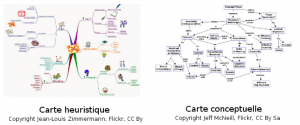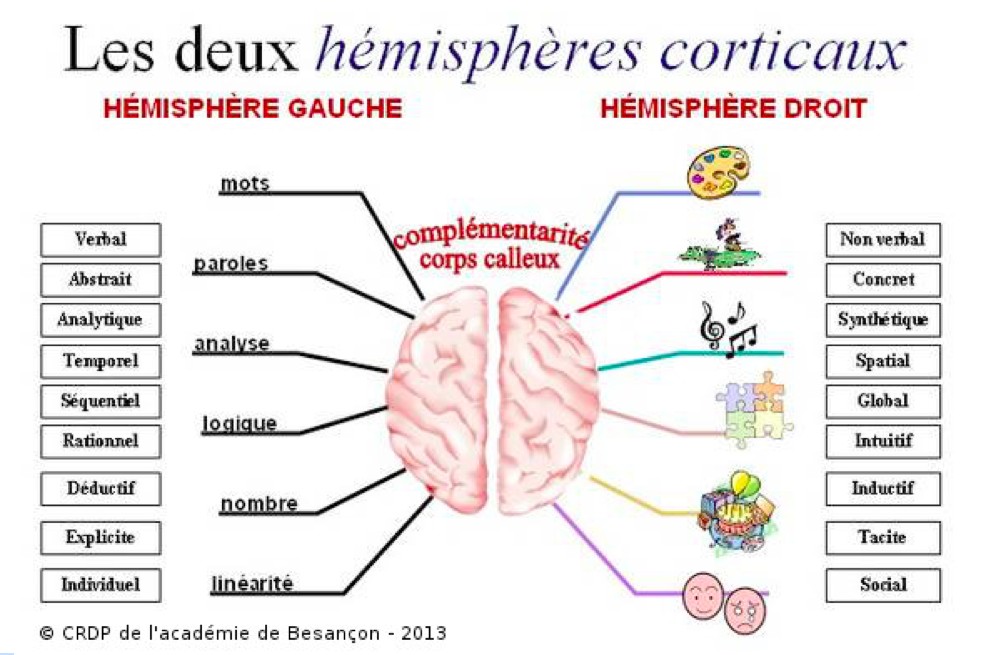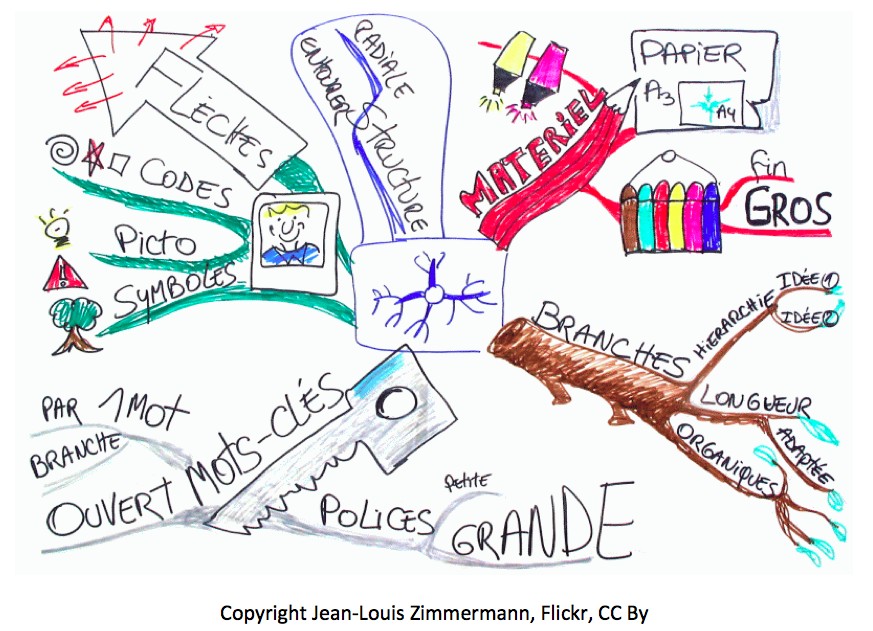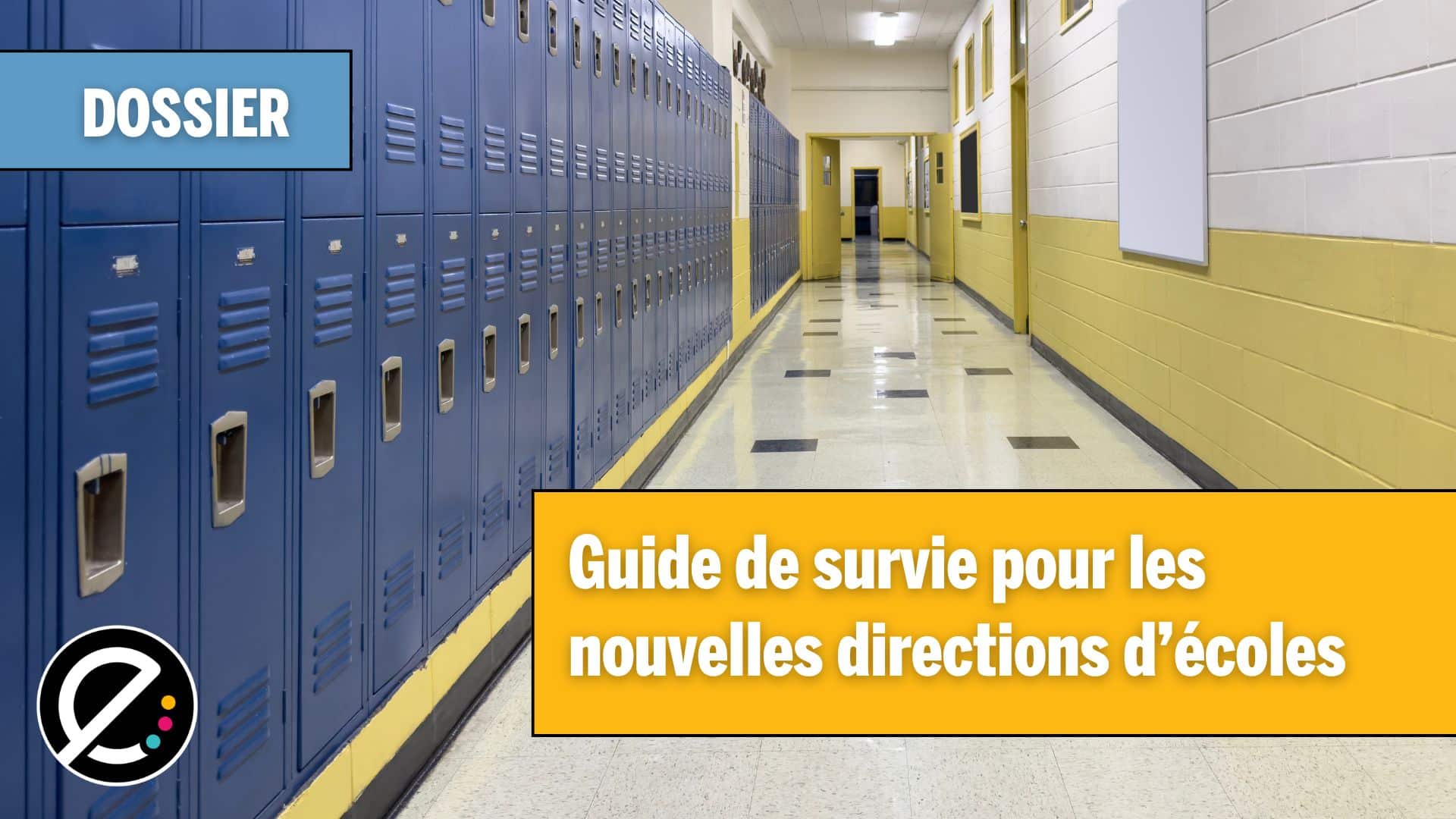Un dossier conjoint de L’École branchée et Carrefour Éducation
Adepte de simplicité pédagogique? Saviez-vous que les cartes mentales constituent l’une des méthodes les plus efficaces et polyvalentes pour assurer la réussite des élèves? Grâce à cette technique d’une commodité désarmante, vos jeunes protégés gagneront en autonomie et prendront le plein contrôle de leurs apprentissages.
Alors que le concept de « carte mentale » émerge dans les discussions et les usages pédagogiques, il semble pourtant vieux comme le monde. En fait, il s’agit d’une réappropriation de méthodes de visualisation et de mémorisation qui remontent à l’Antiquité. Les orateurs romains et grecs s’en servaient, en outre, pour structurer et maîtriser leurs discours, comme le mentionne le site MindMapping.com, qui explique les bases de cette technique. Ce terme (mind mapping) peut se traduire ainsi : « cartographie mentale ». Pourquoi alors faire usage de cette terminologie anglaise? C’est qu’en fouillant sur Google, on a généralement plus de succès avec celle-ci, puisqu’elle s’avère fort populaire en France.
Mind mapping, carte mentale, cartographie… Les dénominations de cette stratégie pédagogique sont légion. D’ailleurs, certains pédagogues classent ces cartes sous deux angles. En consultant Wikipédia ou cet article de Christian Barette, conseiller et formateur Performa (Université de Sherbrooke), on peut mieux comprendre les différences entre ces deux types de cartes, bien que pour les élèves (et souvent, pour les adultes), cela puisse demeurer vague.
– La carte mentale ou heuristique :
Elle propose un contenu en arborescence, des diagrammes et/ou des liens sémantiques ou hiérarchiques entre les idées et concepts. On peut y déceler le cheminement de la pensée. Elle semble plus intuitive et souvent destinée à un usage personnel.
– La carte (ou schéma) conceptuelle :
La structuration des concepts apparaît souvent sous forme de schéma comportant des liens de types relationnels entre les concepts. Elle est reliée à la connaissance d’un concept et peut habituellement être comprise par un autre lecteur.
En fait, la distinction n’est pas évidente, et la ligne séparant ces deux genres, bien mince. Afin d’éviter de confondre les élèves (et les enseignants) dès le départ, vaut mieux s’en tenir à un terme unique. Dans le cadre de ce dossier exposant le b.a.-ba de cette méthode, c’est l’expression « carte mentale » qui sera retenue.
La première partie permettra de découvrir que la création des cartes mentales favorise un usage optimal du cerveau. Preuves à l’appui, le dossier mettra de l’avant divers témoignages et expériences vécues en classe, auprès des petits comme des grands. Outre la mise en évidence des nombreux avantages de cette technique, tant pour faciliter l’apprentissage que pour s’atteler à une variété de tâches, on illustrera également les bases de la conception d’une carte mentale, afin que vous puissiez à votre tour passer à l’action. En complément, on découvre plusieurs logiciels et applications en ligne utiles pour transférer ses cartes du papier à l’écran, et ce, tout à fait gratuitement.
Pratiques, les cartes mentales constituent un virage pédagogique fascinant! Êtes-vous prêt(e) à le relever?
Sommaire du dossier
- Introduction
- Cartes mentales : avantages et usages fréquents
- Les cartes mentales en classe : des exemples
- Contenu et structure
- Du papier à l’écran
- À vos marques… Prêts? « Cartez »!
Cartes mentales : avantages et usages fréquents
En plus de rehausser les capacités cérébrales, dont la mémoire, la carte mentale facilite une variété de tâches scolaires. Cet outil polyvalent peut ainsi jouer un rôle notable dans la réussite des élèves.
Mieux mémoriser et utiliser le cerveau à plein rendement
En général, l’être humain n’utilise pas le plein potentiel de son cerveau. Souvent, un seul hémisphère est sollicité à la fois. Or, l’hémisphère gauche et le droit se complètent, tel que l’illustre cet article comprenant une image synthèse des plus évocatrices. Si le premier réagit mieux aux concepts et à la raison, le second apparaît plus intuitif et artistique. C’est d’ailleurs à ce plan que la carte mentale se distingue des autres méthodes d’apprentissage. En effet, par sa présentation à la fois visuelle (couleurs, images, schémas), logique (liens, organisation des concepts) et linguistique (mots-clés), la carte mentale sollicite l’ensemble du cerveau.
En fait, on peut comparer la carte mentale à la pratique de la natation plutôt qu’à celle de la marche : tous les muscles se mettent en branle, plutôt que ceux des jambes en priorité. Mis en forme par une stimulation plus complète, le cerveau répond par une compréhension accrue des concepts, mais aussi une mémorisation efficace du contenu, que ce soit en guise de rapidité ou d’étendue des connaissances retenues. D’ailleurs, les simples faits de situer les concepts dans l’espace (ici, sur une feuille ou un écran orienté paysage) et d’effectuer des associations constituent des astuces de mémorisation à la portée de tous.
En somme, la carte mentale, c’est de la métacognition à son meilleur! L’élève apprend à apprendre : il construit et structure ses connaissances à sa manière, avec ses propres schèmes de pensées et ses mots-clés, et ce, dans une foule d’occasions scolaires.
La carte mentale, un outil idéal pour explorer, planifier, résumer et réviser
Utile à toutes les sauces, la carte mentale mérite qu’on s’y attarde. Souvent, le premier contact se fait en grand groupe, afin que tous puissent visualiser l’évolution de la carte sur un tableau standard ou sur un TNI / TBI. Graduellement, les élèves l’utiliseront à des fins personnelles pour explorer, planifier, résumer et réviser.
Pour introduire ce type d’outil en classe, on peut commencer par une activité d’exploration. Plus accessible puisque toutes les réponses sont possibles, ce type d’exercice permet aux jeunes de s’approprier la carte mentale sans vivre un stress inutile relié au contenu. Ainsi, on peut organiser une tempête d’idées sur un sujet qui fera l’objet d’un travail de recherche, explorer les thèmes possibles d’une fête ou d’une exposition scolaire, activer les connaissances antérieures de votre classe sur une notion qu’on s’apprête à aborder, etc. Ici, l’expression de soi et la créativité sont au rendez-vous!
On profite ensuite des atouts de la carte mentale pour travailler la planification. Outre l’organisation d’un projet (fête, événement, projet de recherche ou autre travail d’envergure), la carte facilite aussi la résolution de problème. Par ailleurs, c’est l’outil par excellence pour construire un plan de texte dynamique, que ce soit pour un article informatif, un récit ou un texte d’argumentation. Les élèves peuvent également planifier les tâches de la semaine à l’aide d’une carte. Devoirs, leçons, étude, travaux à remettre : tout cela pourra apparaître sur une même feuille et fournir une vue d’ensemble des plus pertinentes pour bien gérer le temps et les tâches et ne rien oublier.
La carte mentale est aussi un outil formidable pour résumer et réviser. Comme l’explique cette vidéo, la prise de notes, la mémorisation et la révision de celles-ci deviennent beaucoup plus rapides, appropriées et optimales avec cette technique. Puisqu’il n’y a que des mots clés à noter, l’élève devient plus actif dans son écoute, que la cible de l’attention soit l’enseignant ou un document multimédia. Même chose quand il s’agit de prendre des notes pendant la lecture. De façon bénéfique, l’apprenant dispose de plus de temps pour se concentrer sur ce qui se passe, plutôt que de tenter de tout prendre en note à la vitesse de l’éclair – et ne pas être en mesure de se relire ensuite. Par ailleurs, comme le choix des mots-clés revient à l’élève, l’apprentissage s’annonce d’autant plus significatif.
Cet outil de révision sert de support pour étudier, mais aussi pour présenter un oral. Par exemple, en plaçant les points importants de son discours sur sa feuille, l’élève n’a qu’à jeter un regarde furtif sur les différents coins de son aide-mémoire, et le voilà à l’aise d’en parler sans risquer les fameux trous de mémoire.
Ainsi donc, la carte mentale offre une panoplie d’avantages et un immense potentiel pédagogique, comme le confirme cet article de Pierre Cohen-Bracie, conseiller pédagogique au Collège Montmorency et cette page du site MindMapping.com. Curieux de découvrir quelques exemples concrets de cartes mentales? Voyez la seconde partie de ce dossier.
Les cartes mentales en classe : des exemples
De plus en plus populaires dans le monde éducatif, les cartes mentales offrent un univers de possibilités, qu’elles soient réalisées en format électronique ou sur papier. Tel que mentionné dans la première partie de ce dossier, qu’il s’agisse d’explorer, de planifier, d’organiser ou de réviser, leur puissance pédagogique s’avère quasi illimitée, tout comme le fait ressortir l’article « Les cartes mentales en classe, pour quoi faire? ». En fait, il n’en tient qu’à l’enseignant et à ses élèves de s’approprier cet outil et de l’utiliser à toutes les sauces. Parions que chez plusieurs apprenants, cela deviendra vite une seconde nature. Voici d’ailleurs plusieurs références vers des sites et vidéos qui rendent bien vivante cette stratégie d’apprentissage, tout en posant un regard critique sur celle-ci.
Pour ce faire, l’article Apprendre à apprendre avec les cartes mentales et le Guide pour l’utilisation de cartes heuristiques en classe (PDF) mettent en évidence les atouts et les limites de l’utilisation des cartes mentales pour l’apprentissage. On y trouve de nombreux liens vers des exemples de cartes réalisées en classe. On y remarque, en guise de principal avantage, la rapidité d’exécution de ces cartes, qu’elles soient réalisées à l’écran (TBI / TNI, tablette numérique ou ordinateur standard), sur une feuille ou même à l’aide de « post-it » que l’on déplace sur un pupitre. Évolutives, elles facilitent l’insertion de nouveaux mots-clés, d’associations ou de liens. En consultant le blogue Pétillant – Le site expert de la carte heuristique, qui comporte plusieurs exemples d’applications, on peut effectivement constater ces atouts majeurs dans divers contextes.
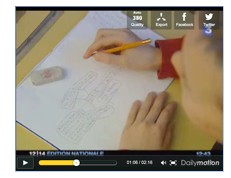
Mises en forme individuellement, en équipe ou en grand groupe, les cartes mentales conviennent à tous les types d’organisation du travail. Au préscolaire, les cartes sont plus souvent fabriquées en grand groupe, à l’aide du TBI / TNI. Cela dit, les élèves pourraient également être amenés à créer leurs propres cartes en usant exclusivement de dessins ou d’images. Lorsque vient le moment d’aborder un thème en classe, les enseignants peuvent recourir à la carte pour sonder les connaissances antérieures des jeunes, leurs questionnements et leurs intérêts.
Au primaire, les cartes sont souvent utilisées lors de la mise en branle de projets. Par exemple, cette classe utilise la carte pour délimiter les possibilités de sujets de recherche et soutenir les élèves dans le choix. En Finlande (de même qu’en France, où la notion de carte mentale a été intégrée au programme éducatif depuis 2010), on incite les élèves à utiliser la carte pour prendre des notes. Cette courte vidéo montre des élèves en plein travail.
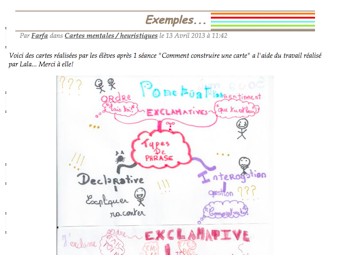
D’ailleurs, il ne faudrait pas s’imaginer que les cartes permettent simplement de se remémorer et d’organiser des informations en univers social ou en sciences. Pour l’apprentissage de la grammaire ou même des mathématiques, elles constituent un atout majeur. Ici, par exemple, les enfants les utilisent pour distinguer les types de phrases. En comparant les cartes de plusieurs élèves, l’enseignant constate qu’un même sujet génère différents résultats, car chaque apprenant structure sa pensée à sa façon, tout en utilisant des mots-clés évocateurs pour lui.
Que ce soit au primaire ou au secondaire, tous les projets sont propices à l’utilisation de cartes mentales. Dans cette vidéo d’un peu moins de vingt minutes, on constate l’enthousiasme des jeunes à l’égard de la méthode. Après que l’enseignante ait modélisé la façon de repérer les éléments importants dans un texte, les élèves sont invités à les organiser dans une carte. Ils témoignent et passent à l’action à l’aide d’une variété de moyens technologiques ou traditionnels. Cette petite enquête, menée auprès d’élèves après un an d’utilisation de la méthode, confirme leur intérêt.
En guise d’exemple, ces deux vidéos où les cartes mentales sont utilisées pour élaborer des textes argumentatifs ou des récits (à l’aide du TBI / TNI) pourront intéresser les enseignants de français du primaire comme du secondaire. Sur le blogue Lettres et cartes heuristiques, on illustre comment l’enseignement du français (et même du latin) peut être facilité à l’aide de cette stratégie.
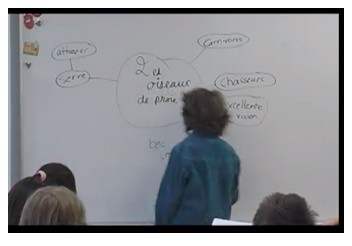
Pour leur part, les enseignants de langue seconde ont aussi tout intérêt à développer cette technique avec leurs élèves. Bonne nouvelle : le vocabulaire souvent limité des jeunes dans une autre langue devient un atout pour la création de cartes, car ces derniers n’ont alors pas tendance à formuler des phrases, mais plutôt à synthétiser.
Ainsi, la carte mentale, comme l’indiquent les résultats de l’« Enquête auprès des élèves de 3e après un an d’utilisation des cartes », constitue une stratégie pédagogique des plus adaptables que les élèves s’approprient prestement, dans une multitude de contextes, et à l’aide d’une panoplie d’outils.
Comment construire une carte mentale? C’est ce que nous verrons dans la prochaine partie de ce dossier.
Cartes mentales : contenu et structure
Réaliser une carte mentale peut prendre trente secondes, comme constituer un laborieux exercice s’apparentant à une véritable création artistique. En fait, le temps nécessaire à sa finalisation dépendra de l’organisation du schéma et, surtout, de la quantité d’éléments que les élèves y intégreront. Les lignes qui suivent mettront en relief ces caractéristiques, tout comme cette vidéo pratique intitulée Le Mind Mapping en moins de 4 minutes ou cette série de vidéos sur les cartes mentales.
La double structure des cartes mentales
D’abord, deux structures de pensée se situent à la base de cette technique. L’éclosion (ou brain bloom) se compare à une fleur ou à un soleil. Au centre se situe l’idée principale alors qu’en périphérie s’étalent les idées secondaires. Le flux d’idées, quant à lui, passe d’une idée à l’autre sur une même lignée. Chaque mot réfère uniquement au précédent. Ainsi, le concept de départ n’est directement associé qu’à un seul autre terme.
La méthode : éléments de bases à exploiter dans la création d’une carte
Quelle que soit la façon dont on relie les mots-clés, voici quelques éléments à considérer dans la construction de la carte. D’abord, il est préférable de la réaliser sur une feuille ou sur un écran selon l’orientation paysage (c’est-à-dire que l’espace de création est plus large que haut). On commence par placer le sujet principal en plein centre (au cœur) du médium. Ces deux particularités auront pour effet de favoriser la focalisation de l’attention sur le thème.
Autour du sujet principal, on crée des branches qui mèneront vers d’autres mots-clés, ce qui explique la réputation « végétale » de ces cartes, que l’on compare souvent à des arbres. L’épaisseur des branches pourra varier, selon l’importance qui leur est accordée. Sur chacune d’entre elles, et/ou au bout, s’installe un mot-clé. Rapidement repérés, ces mots évoquent un sens, une signification. Idéalement, il faut inciter les élèves à ne pas recourir à la phrase, ce qu’ils ont l’habitude de faire lorsqu’ils prennent des notes de manière traditionnelles. Les mots-clés obligent le cerveau à créer des liens et à peaufiner sa compréhension : voilà un atout pour un apprentissage plus efficace. Évidemment, même si les expressions ne sont pas situées sur la même branche, des liens et flèches additionnels peuvent les relier.
Cela dit, le vocabulaire n’a pas l’exclusivité de la carte. Les images y jouent un rôle essentiel, puisqu’elles permettent un gain d’espace, mais aussi qu’elles favorisent le développement des idées. En effet, l’image laisse place à une plus grande gamme d’interprétations et de concepts. Les icônes ont aussi la côte. Parmi les plus populaires, notons le « ? » ou encore « $ ». Les émoticônes, les nombres ou autres symboles ont aussi tout intérêt à être intégrés et standardisés d’une carte à l’autre, pour gagner en rapidité. Au plan visuel, la couleur constitue aussi un élément distinctif permettant au cerveau d’associer et de regrouper plus aisément les concepts. On peut, par exemple, entourer d’une couleur différente chaque idée secondaire et tout ce qui en découle sur la carte. On peut aussi indiquer en vert tout ce qui est positif, et en rouge ce qui est négatif, pour utiliser l’analogie des feux de circulation.
Bien sûr, si on prend soin de considérer toutes ces astuces afin d’élaborer une carte complète, le processus peut sembler long et complexe, surtout sur une feuille. Bien que les cartes sur papier aient leurs avantages, celles produites à l’aide des TIC présentent des bénéfices importants.
Cartes mentales : du papier à l’écran
Carte papier ou à l’écran : quoi choisir? En fait, le mot d’ordre peut être le suivant : une étape à la fois, selon ce à quoi la classe a accès.
Le papier…
Lors de l’initiation des élèves à la technique des cartes mentales, il peut être intéressant de commencer avec du papier et un crayon, souvent plus facilement accessibles en milieu scolaire. Il faut idéalement se munir aussi de crayons de couleurs ou de marqueurs et le tour est joué. Effectuer une razzia dans le bac de recyclage permettra de récupérer feuilles et retailles qui conviennent tout à fait aux cartes brouillon, souvent nécessaires lorsqu’on réalise ses cartes à la main plutôt qu’à l’aide d’un support informatique. La création sur papier transformera la technique en une seconde nature et permettra aux nombreuses œuvres des élèves d’être classées dans un cartable d’idées ou affichées aisément en classe. Une fois le concept bien établi, on peut proposer l’usage de logiciels ou d’applications en ligne afin d’obtenir des cartes mieux structurées, visuellement plus agréables et faciles à modifier.
L’écran…
La technologie permet de créer aisément des cartes mentales, de les enregistrer, de les partager, de les imprimer, de les publier sur le Web… Intéressant et utile! Cela dit, il peut sembler ardu de choisir le logiciel ou l’application qui convient le mieux, puisqu’une foule de produits existent. Alors que certains semblent gratuits, on constate souvent que ce n’est que la version de base qui l’est réellement. Il faut ensuite payer pour une version plus complète. Des sites en ligne, pour leur part, proposent parfois un abonnement mensuel. Avant d’y adhérer, il est bon de faire le calcul afin de déterminer s’il n’est pas plus avantageux, à long terme, d’acheter un logiciel. En furetant sur divers forums d’utilisateurs, on constate que les avis sont partagés sur tous les produits offerts. Bonne nouvelle, c’est signe qu’il y en a pour tout le monde, comme le souligne cet article qui met en évidence cinq outils pratiques ou encore celui-ci qui utilise le principe de cartes mentales pour illustrer les avantages et inconvénients de diverses applications.
Logiciels à télécharger
Certains logiciels sont complets et gratuits. C’est le cas de FreePlane, un logiciel libre. Convivial, il comporte bon nombre d’icônes, de couleurs et de possibilités. Comme il est libre, on peut l’installer aussi bien à l’école qu’à la maison. Si l’aspect des cartes semble quelque peu austère, le choix d’icônes demeure intéressant. En copiant la carte vers Libre Office ou Microsoft Office, on obtient une version « texte » de toutes les notes, en d’autres mots : un plan détaillé et bien structuré. On peut aussi ajouter des commentaires dans la carte, non visibles sur le schéma (une petite icône indique leur présence), mais qui seront intégrés dans le fichier si on en fait un copier-coller vers un autre logiciel. Cela pourra, par exemple, inciter à réaliser des plans de textes directement dans FreePlane, puis à transférer le tout ensuite afin d’obtenir un travail quasi final.
Autre logiciel à découvrir, la version gratuite de Xmind se compare à Freeplane. Si les cartes sont un peu plus jolies, le choix d’icônes apparaît cependant plus limité. Les deux logiciels sont sensiblement aussi conviviaux, mais Xmind offre des modèles de base plus intéressants. Atout pratique : on peut exporter ses cartes en format PDF. Dans la version Pro, on peut ajouter des fichiers MP3 aux cartes. Ceci est pratique pour enregistrer des commentaires oraux dans une carte.
Certains utilisateurs ne jurent que par CmapTools. On trouve d’ailleurs dans cet article les avantages et bénéfices de ce logiciel, et aussi un lien pour le télécharger.
Du côté des logiciels propriétaires, on retrouve dans plusieurs écoles du Québec les titres SMART Ideas, de la compagnie qui fabrique les tableaux SMART Board, ainsi que Inspiration et Kidspiration (adapté aux plus jeunes), dont les qualités visuelles et la facilité d’utilisation ont souvent été soulignées.
Applications en ligne
Afin d’éviter les installations de programmes et de favoriser le suivi du travail des élèves de l’école à la maison, l’utilisation d’une application en ligne est avantageuse. Certaines se combinent également à des applications pour les téléphones intelligents, ce qui permet d’améliorer ses cartes en tout temps.
Un grand nombre d’outils existe et, encore une fois, tous les goûts sont dans la nature. Alors que certains apprécient Mindmeister ou Bubbl.us, d’autres préfèrent Canva, Cacoo.com, Popplet, Coggle, Mindmanager, BiggerPlate ou Mindomo. Ces applications, dans leur version gratuite, limitent la plupart du temps le nombre de cartes produites ou n’offrent pas toutes les fonctions de la version payante.
Après plusieurs lectures, j’ai décidé d’essayer les applications en ligne SpiderScribe, iMindMap et MindMup, qui semblaient avoir la cote auprès de plusieurs enseignants consultés. SpiderScribe m’est apparu très convivial, quoiqu’il ne comporte pas d’icônes. Bien que le nombre de cartes privées se limite à trois, le nombre de cartes publiques permises est illimité. On peut d’ailleurs les partager aisément, ou encore les exporter en format PNG (image) qu’on peut ensuite intégrer dans un autre document au besoin. Cet outil se distingue par les fonctions « ajout de cartes » (à partir de Google Maps) et « ajout de calendriers ». L’ajout d’images est aussi très simple.
Moins convivial au premier abord, iMindMap se démarque toutefois par une variété de modèles des plus esthétiques et variés. Un certain nombre d’icônes sont disponibles. Si on se donne la peine de se l’approprier, les cartes seront visuellement fort attirantes.
Pour ce qui est de MindMup, il s’utilise avantageusement avec le compte Google, ce qui permet d’en partager les fruits directement sur le site ou via GoogleDrive. Malgré une interface en anglais, il s’avère très convivial et les jeunes du primaire se l’approprieront en un rien de temps.
Le logiciel GitMind peut, quant à lui, être utilisé sur plusieurs plateformes (Android, iOS et en ligne). Il offre des modèles diversifiés et permet de collaborer en ligne en temps réel sur une même carte mentale. Le résultat peut être exporté en différents formats.
Carte mentales, la conclusion : À vos marques… Prêts? « Cartez »!
Quel que soit l’outil choisit pour créer des cartes mentales, avec un peu de pratique, il finira par devenir convivial. Il s’agit de prendre le temps d’explorer par soi-même diverses applications (jetez un coup d’œil au tableau comparatif sur cette page ou encore sur ce pratique billet) et de sélectionner celle qui convient le mieux.
Astuce : si votre application ne permet pas de sauvegarder votre carte sous forme d’image (JPG ou autre), vous pouvez imprimer votre écran (PC : touche « Impr écran » + Windows ou FN sur le clavier, Mac : touches CMD + MAJ + 4 puis sélectionner la zone) puis coller cette image dans un logiciel de traitement d’images (comme Paint, par exemple). Il ne vous reste qu’à sélectionner votre carte et à l’enregistrer dans le format voulu.
Tel qu’il a été expliqué dans ce dossier, les cartes mentales permettent de rehausser la réussite et l’implication scolaires des élèves. Avec un minimum d’investissement, l’enseignant obtient un maximum de résultats. En quelques semaines, chacun arrivera à maîtriser cette méthode et en fera un outil qui répond à tous les besoins pédagogiques, ou presque!
Si vous en voulez plus, consultez cet intéressant dossier synthèse de Laetitia Carlier, psychopédagogue. Vous préférez l’image à la lecture? Dans cette conférence à l’intention des enseignants (57 minutes pour la première partie; 50 minutes pour la seconde), Gérard Cervi, spécialiste du mind mapping, effectue un tour de la question de façon captivante, tout en incitant à lâcher prise pour permettre au cerveau de fonctionner à pleine rendement.
Sur ce, bonne exploration!




